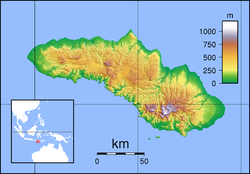Flora and fauna
There are about 118 plant species protected in this national park including Toona sureni , Sterculia foetida , Schleichera oleosa , Alstonia scholaris (ditabark), tamarind, candlenut, Syzygium species, Casuarina species, and Lantana camara (Spanish flag). [1]
There are also 87 species of birds protected in this region, with 7 bird taxa endemic to the island of Sumba. These are Sumba yellow-crested cockatoo, Sumba green pigeon, Sumba flycatcher, Sumba cicadabird, apricot-breasted sunbird and Sumba hornbill.
57 species of butterflies are also protected here, 7 of them are endemic to this island. These are Papilio neumoegenii , Ideopsis oberthurii , Delias fasciata , Junonia adulatrix , Athyma karita , Sumalia chilo , and Elimnia amoena .
This page is based on this
Wikipedia article Text is available under the
CC BY-SA 4.0 license; additional terms may apply.
Images, videos and audio are available under their respective licenses.

